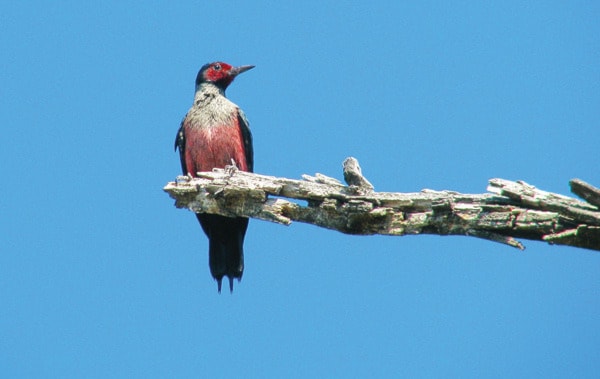A provincial wilderness program is asking bird watchers to keep their eyes out for Lewis’s woodpeckers, a bird species that is precariously perched on the federally threatened species list.
“It’s always disappointing and discouraging to see a species slowly declining, especially the Lewis’s woodpecker, which is a spectacular bird,” said local biologist, author and birder Dick Cannings.
“Especially if anyone saw this bird close up, they’re not your average woodpecker. They’re really classy looking birds, very different from a lot of other woodpeckers.”
This decline is the cause behind the Wildlife Tree Stewardship Program’s interest in them. Lisa Scott, Okanagan-Similkameen co-ordinator with the program, said that by recording the whereabouts of the bird, the program would be able to better understand their habitat needs and ultimately better protect the birds.
One of the largest obstacles facing the species in the region, Scott said, is the disappearance of the dead or dying trees that the bird uses for nesting.
“The big issue I see is that landowners will see trees that are dead or dying and automatically assume they’re a danger tree and cut them down.” Scott said. “A lot of the time, the trees are quite safe. Dead ponderosa pine trees can stay standing for many, many decades — 80 to 90 years — and they’re not going to fall on anyone or anything.”
This is the exact scenario that Cannings has seen play out himself.
“There was a pair right in downtown Penticton that everybody knew, and all the birders coming in town looking for Lewis’s woodpeckers knew all you had to do was go to the corner of Eckhardt and Martin,” he recalled.
“There was an old property there that they harvested acorns from and nested, and then the property changed hands and they cleaned up the big old trees and took out the bits that had nests and storage parts in it, and (the birds) disappeared overnight.”
The loss of their nesting habitat isn’t the only issue facing the bird. The starling, an invasive bird species, can often take over the woodpecker’s nesting cavities in the chance a suitable tree is found. As well, the constant suppression of forest fires has had a number of effects on the bird.
While most people would view forest fires as a bad thing, Scott explained that they actually serve to rejuvenate forests, opening up dense areas, creating nest trees that the woodpeckers rely on and drawing in the insects the birds eat. When naturally occurring fires are suppressed, the forests tend to grow in on themselves.
“They catch insects in the air, so if you have a really dense forest, the birds can’t sweep out and grab insects in the air because there’s trees there, so there’s a visible barrier. When a fire does come, (the birds) like that because insects come after a fire. Also the fire opens it up. They’ve got that food supply now, it’s been opened up so they can fly about and flit in the air, and as long as there’s nest trees in abundance, they’re quite happy.”
While there certainly are a plethora of issues facing the bird, both Cannings and Scott remained hopeful about its future, saying that greater education is needed for land owners and habitat managers.
As opposed to cutting down dead or dying trees, they said, it would be better to chop off the parts that are in danger of falling off while leaving the lower, hazard-free trunk available for nesting.
As well, Scott said there are wildlife and danger tree assessors who can examine trees and check the danger they pose, which could potentially save cutting the tree at all.
For more information or to report a Lewis’s woodpecker or one of their nest trees, call Lisa Scott at 250-404-0115 or reach her by email at witsos@shaw.ca.
